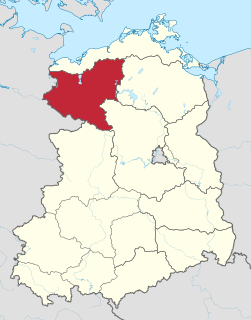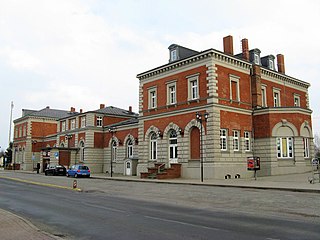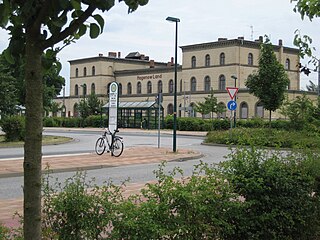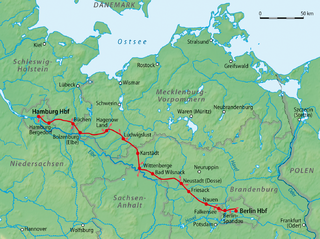
Mecklenburg is a historical region in northern Germany comprising the western and larger part of the federal-state Mecklenburg-Vorpommern. The largest cities of the region are Rostock, Schwerin, Neubrandenburg, Wismar and Güstrow.

The Grand Duchy of Mecklenburg Friedrich-Franz Railway was the state railway company in Mecklenburg-Schwerin and Mecklenburg-Strelitz. After its second nationalisation in 1890 up to the merger of the Länderbahnen into the Deutsche Reichsbahn in 1920 it was under the direction of the Grand Duchy's Executive Railway Board in Schwerin.

The Bezirk Schwerin was a district (Bezirk) of East Germany. The administrative seat and the main town was Schwerin.

The Neustrelitz–Warnemünde Railway is a railway line in the North German state of Mecklenburg-Vorpommern. Most of the line is a double-tracked, electrified main line and runs for almost 130 kilometres from Neustrelitz to Warnemünde. It is also known in German as the Lloydbahn, referring to the Deutsch-Nordischer Lloyd company, which built the line and operated it in its early years after its opening in 1886.

The Bützow–Szczecin railway is a nearly 200 km-long, mostly non-electrified, single-track main line railway running mostly in the German state of Mecklenburg-Vorpommern. The first section of the line between Bützow and Güstrow was opened in 1850 by the Mecklenburg Railway Company and is one of the oldest railways in Germany and is part of the Leipzig–Magdeburg–Schwerin–Rostock main line.

Schwerin Hauptbahnhof is the main railway station of the capital of the German state of Mecklenburg-Vorpommern and is located in the northwest of the central city. It includes four tracks on two platforms and a siding west of the fourth track. Currently the station is used by about 12,000 passengers a day.

Neustrelitz Hauptbahnhof is a railway station in the city of Neustrelitz, Mecklenburg-Vorpommern, Germany. The station lies on the Stralsund-Neubrandenburg railway, Neustrelitz–Warnemünde railway and Wittenberge–Strasburg railway. The train services are operated by Deutsche Bahn, Ostseeland Verkehr and Ostdeutsche Eisenbahn.

Ludwigslust is a railway station in the town of Ludwigslust in the German state of Mecklenburg-Vorpommern. The station was opened in 1846 and lies on the Berlin–Hamburg Railway, the Ludwigslust–Wismar railway, the Parchim–Ludwigslust railway and the Ludwigslust–Dömitz railway. The station building, platform, engine shed and water tower are heritage-listed.

The Lübeck–Bad Kleinen railway is a single-track, non-electrified main line between the German states of Schleswig-Holstein and Mecklenburg-Vorpommern. Its construction was started by the Lübeck-Kleinen Railway Company and, after that company’s bankruptcy, it was completed and opened by the Friedrich-Franz Railway (Friedrich-Franz-Eisenbahn).

Bad Kleinen station is in the community of Bad Kleinen and is one of the oldest and most important railway stations in the German state of Mecklenburg-Vorpommern. It primarily operates as a transfer station for traffic to and from Wismar, Grevesmühlen / Lübeck, Schwerin and Bützow / Güstrow / Rostock.

Bützow station is in the city of Bützow in the district of Rostock in the German state of Mecklenburg-Vorpommern and is served in local and long distance services. It is on the Bad Kleinen–Rostock railway and is the starting point of the line to Szczecin.

The Grand Duchy of Mecklenburg Friedrich-Franz Railway grouped various 2-4-0 steam locomotives built between 1849 and 1856 into its Class II. These included five locomotives that had originally been delivered with a 2-2-2 wheel arrangement.

Hagenow Land station is a railway junction in Mecklenburg-Vorpommern, which was opened on 15 October 1846. It is located about 2.5 kilometres from the centre of the small town of Hagenow. It is classified by Deutsche Bahn as a category 5 station.

Grabow (Meckl) station is located on the Berlin–Hamburg railway in Grabow in the south west of the German state of Mecklenburg-Vorpommern. Together with four other stations, which also opened on 15 October 1846, it is the oldest station in the state. The Neoclassical entrance building, which dates from the opening of the line, and some other buildings in the station area are heritage-listed.
The Güstrow–Schwaan railway is a single-track, electrified main line in the German state of Mecklenburg-Vorpommern.

Lalendorf station is located in the municipality of Lalendorf in the German state of Mecklenburg-Vorpommern. The Neustrelitz–Warnemünde railway and the railway from Bützow to Neubrandenburg cross near the station. Both lines originally had separate station facilities, both located on the same station forecourt. Since the Neustrelitz–Warnemünde railway was rebuilt in 1960, it bypasses the Lalendorf station, but it is connected to it by a connecting curve. The station’s entrance building and several other buildings in the station area are heritage-listed buildings.

Blankenberg (Meckl) station is a railway junction in the German state of Mecklenburg-Vorpommern. The station was opened on 13 May 1850 and is one of the oldest railway stations in this state. It is at the intersection of the Bad Kleinen–Rostock and the Wismar–Karow railways. Regular passenger services run only on the former route. Most of the Wismar–Karow railway is closed, but between Blankenberg, Sternberg and Dabel there are occasional freight trains.
























